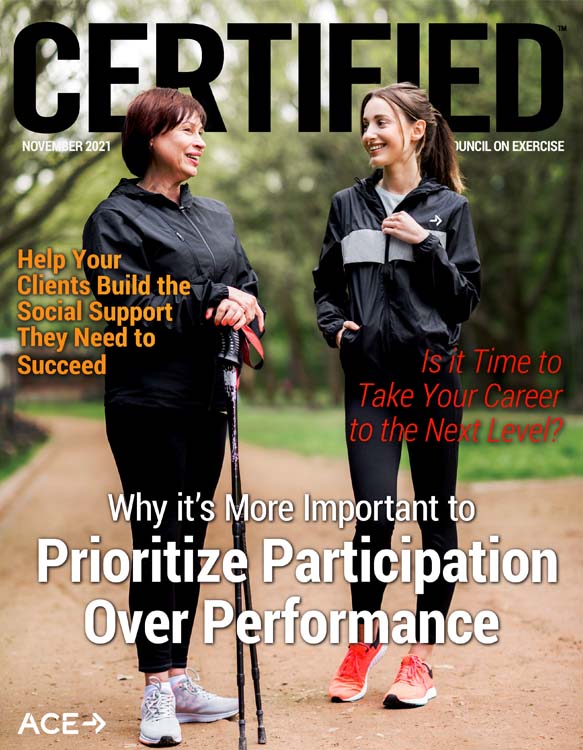
It’s 1983 and I’m sitting at the kitchen table with my two older brothers. We range in age from 10 to 16 years old and are rolling our eyes as our mother explains to us that we’re going to have to start making our own breakfast on school days and clean up after ourselves before we head out the door. Across the street, her best friend Terri is giving the same speech to her four equally dismayed sons. My mom and her friend have decided they want to get in better shape and have a plan: They will meet out front at 7:00 AM Monday through Friday and walk a two-mile loop they’ve mapped through the neighborhood. No early-morning, rotary-dialed phone calls to confirm or cancel. They will meet outside, rain or shine, hot or cold, and they are allowing no room for excuses.
Mom and Terri were clearly early adopters of some now well-known behavior-change strategies: social support, accountability, SMART goals and a focus on process over progress. Unfortunately, not everyone can take my mother’s approach and simply dictate to their loved ones how it’s going to happen (though “go for a walk, prepare your own food and clean up after yourself” is a pretty solid behavior-change plan).
Every health coach and exercise professional knows the value of social support and accountability when it comes to making behavioral changes. As it’s explained in The Professional’s Guide to Health and Wellness Coaching:
Adequate social support is a strong predictor of successful behavior change. Social support can influence client behavior in many ways. Friends and acquaintances influence a client’s perceptions about social norms, health, and health behaviors. Positive social connections can increase a client’s self-efficacy and motivation. Friends can help clients address problems and provide emotional support when feelings of stress threaten to interfere with behavior-change intentions.
Social support inside the home—whether from a spouse, children, parents or roommates—can be particularly impactful, as that is where clients are making most of their decisions about what to eat and how to use their free time. Social support, alongside accountability (like having your best friend already waiting outside, ready to walk), is often the glue that holds people’s behavior-change efforts together, explains Niki Campbell, owner of The Flourish Group, a Pittsburgh-based communications and wellness consulting firm.
Amber Long, MED, Executive Director of Wellness and Recreation Services at the University of Colorado in Denver, agrees. People who have social support from the people around them in their everyday life, she says, “are more likely to feel pride about their efforts and feel supported in a way that helps them maintain their habits.”
As with all things related to health, fitness and behavior change, it’s important to be mindful of the fact that personalization is vital, as social support can mean something different to each of your clients. Anna Szymanski, MS, CSCS, an Asheville, N.C.–based college instructor and ACE Certified Health Coach, Personal Trainer and Group Fitness Instructor, says that the need for social support exists on a spectrum. “We all need social support, but we don’t all need the same amount or the same kind,” she explains. “Some people need a lot of social accountability and others can be more independent, but we all need some kind of validation or confirmation of our efforts.”
The flipside of the importance of social support in successful behavior change is the acknowledgment that some clients may not have the support they need or desire at home. In some cases, that lack of social support can even manifest as a form of sabotage, even if it’s unintended. For example, a spouse may bring home a client’s favorite sweets in an effort to cheer them up when they’re struggling, or roommates may hassle a client for skipping happy hour to go to the gym on the way home from work out of a genuine desire to socialize with them.
How to Bring People on Board
As a health and exercise professional, you can play an important role in helping your clients garner support from the people in their lives. The saboteurs in the examples above may not have meant to undermine the client’s efforts and their lack of support may stem from not understanding how important the behavior change is to the client.
Campbell, who is also an ACE Certified Personal Trainer and Health Coach, offers four strategies that you can use to help your clients bring their loved ones on board.
As with most things, the first strategy involves communication. If you want to influence someone or get buy-in from a group or a person, Campbell explains, it’s all about communicating how and why you want to make a change. Clients should be sure to communicate to the people around them why the behavioral changes are so important to them and explicitly ask for their support. It’s important that reluctant family members or friends understand that there is a difference between supporting the behavior change and joining the client on that journey. The client is not asking their spouse to change their own behaviors, but instead to support the client as they modify theirs.
Szymanski suggests that health coaches and exercise professionals role play conversations with reluctant family members who may feel threatened by them making healthy choices or feel imposed upon, even though the client is well-meaning in their request for support. The role play can focus on the client’s feelings of why the behavior change is so important to them and asking for validation and support from their loved ones.
The second strategy involves including loved ones in the process. For example, you might ask a client’s reluctant family member to join or listen in on a session so they can learn what this process is going to be like, why it’s so important to the client and how it aligns with the client’s values and goals. Understanding the client’s underlying “why” can be very enlightening for a spouse or family member.
“If a family member is reluctant, the client can explore ways to get them involved that they may find more interesting or exciting,” says Long, who is an ACE Certified Personal Trainer, Health Coach, Group Fitness Instructor and Medical Exercise Specialist. For example, the client may enjoy going to the gym five days a week, while their spouse prefers outdoor exercise. In this case, incorporating a weekend hike into the routine, even if it’s not the client’s preferred exercise modality, may be a great way to bring the spouse on board.
Also, clients can’t expect their friends and family members to strictly police their efforts, as that is unfair to the people around them and sure to lead to some tension. As Campbell points out, the top priority for the people who love you the most is often to see you happy, not to see you change.
Finally, Campbell says that if a client has a reluctant partner, the client should be sure to encourage and celebrate moments of support, no matter how small they may be. Acknowledgement of effort is a two-way street, so saying “thank you for helping me prepare dinner” or “thanks for walking with me today,” can help elicit further support in the future.
The third strategy involves making small, incremental changes in the household, explains Campbell. Announcing global changes—“We’re all vegan now!”—is never going to work. Instead, the client can tell their family that they’re going to reduce the amount of soda that’s in the house to encourage everyone to drink more water, for example.
Patience here is key. Just because your client has made up their mind that it’s time to change their lifestyle does not mean that their loved ones are equally ready for behavior change or for changes in how the household is going to function. Encourage clients to create awareness of what they’re trying to accomplish and give family members or roommates time to adjust.
Being consistent and serving as a role model is the fourth strategy. If the client sticks to a new fitness regimen, goes for walks after dinner or spends some time every Sunday doing meal prep, eventually other members of the household will take note and begin to realize that these efforts are going to be real and ongoing.
When it comes to role modeling, Szymanski says that clients can get family members or roommates involved without making a sales pitch. “There are two ways to present options,” she explains. “It can either be inviting or be off-putting and cause tension.” Clients can invite members of the household to join them on walks and to food prep rather than pushing these ideas on them. In addition, Szymanski suggests that clients offer reflections as part of the conversation during healthy behaviors. During meal prep, saying, “I always feel so much better when I do this. It takes a little planning and effort, but it will be worth it when I’m set up for a week of healthy eating,” is a lot more impactful than telling a spouse day after day, “We need to start eating healthier dinners.”
When Social Support Simply Doesn’t Exist in the Home
Unfortunately, there are going to be situations when a client simply does not have social support at home. Campbell suggests that health coaches and exercise professionals prepare their clients for that reality rather than encouraging them to continually push family members who are not going to be supportive. Pushing too hard may increase the tension and only make matters worse.
So, how can you help your clients navigate these scenarios and find the social support they need?
The key, says Campbell, is for the client to find someone outside the home who cares about their success or, better yet, a friend or coworker who shares their goal and wants to join them on a behavior-change journey.
Long echoes this idea, saying that clients should “seek other means of social support. That could come in the form of social media groups, or groups at the gym, community center or workplace.” There is a dissonance that happens, she warns, when people have social support outside the home but not in the place where they’re cooking, preparing and eating food, and doing other things to improve their health, so health coaches and exercise professionals should prepare their clients for that reality. Importantly, Long says that having strong support outside the home can safeguard the client against negative feelings that might arise stemming from this dissonance.
Another tool that can be used when social support is hard to come by is SMART goal setting. “Goal setting is important in this scenario,” says Long. “If there is an external goal that a person can really focus on, that can keep them moving forward even in those moments when no one else wants to go on the journey with them.” SMART goals can help clients develop self-efficacy, autonomy and confidence. As Long explains, “Setting and meeting goals can keep people motivated even when they feel challenged by people not supporting them.”
Speaking of SMART goals, Szymanski suggests clients have a weekly conversation, phone call or zoom chat with a supportive friend as part of their behavior-change plan. Planning support in this way emphasizes its importance, which can be empowering for many clients.
In Conclusion
Social support inside the home is an important element of success for anyone trying to live a healthier lifestyle. When working with clients who do not have the degree or type of social support they are hoping for, health coaches and exercise professionals should suggest strategies for bringing loved ones on board with the plan. If that’s not possible, brainstorming alternate sources of social support and setting SMART goals that enhance self-efficacy and autonomy becomes vital.
Everyone’s behavior-change journey is unique and not everyone has people in their home who are willing to encourage or even join them along the way. However, that does not mean that the destination isn’t the same. Some clients just may have different traveling companions than others or may even have to go it alone for some stretches, but improved happiness, health and overall well-being is still well within reach.





 by
by 





